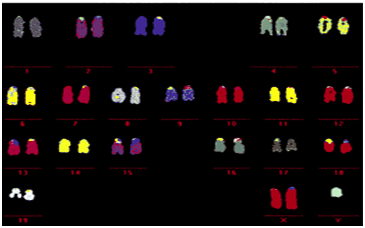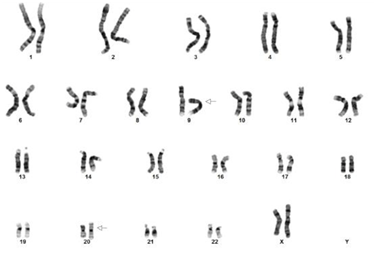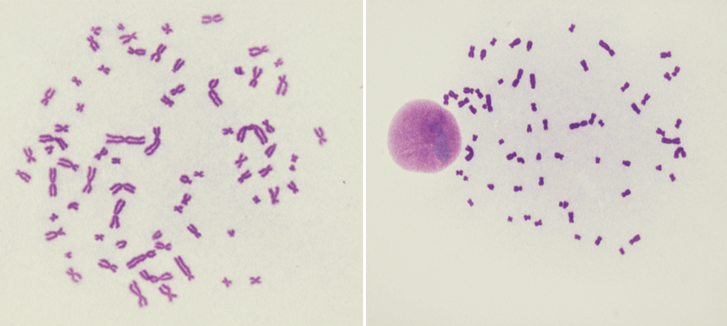- You are here: Home
- Services
- ISH/FISH Services
- FISH Applications
- Chromosome Analysis of ES Cells and iPS Cells
Services
-
Cell Services
- Cell Line Authentication
- Cell Surface Marker Validation Service
-
Cell Line Testing and Assays
- Toxicology Assay
- Drug-Resistant Cell Models
- Cell Viability Assays
- Cell Proliferation Assays
- Cell Migration Assays
- Soft Agar Colony Formation Assay Service
- SRB Assay
- Cell Apoptosis Assays
- Cell Cycle Assays
- Cell Angiogenesis Assays
- DNA/RNA Extraction
- Custom Cell & Tissue Lysate Service
- Cellular Phosphorylation Assays
- Stability Testing
- Sterility Testing
- Endotoxin Detection and Removal
- Phagocytosis Assays
- Cell-Based Screening and Profiling Services
- 3D-Based Services
- Custom Cell Services
- Cell-based LNP Evaluation
-
Stem Cell Research
- iPSC Generation
- iPSC Characterization
-
iPSC Differentiation
- Neural Stem Cells Differentiation Service from iPSC
- Astrocyte Differentiation Service from iPSC
- Retinal Pigment Epithelium (RPE) Differentiation Service from iPSC
- Cardiomyocyte Differentiation Service from iPSC
- T Cell, NK Cell Differentiation Service from iPSC
- Hepatocyte Differentiation Service from iPSC
- Beta Cell Differentiation Service from iPSC
- Brain Organoid Differentiation Service from iPSC
- Cardiac Organoid Differentiation Service from iPSC
- Kidney Organoid Differentiation Service from iPSC
- GABAnergic Neuron Differentiation Service from iPSC
- Undifferentiated iPSC Detection
- iPSC Gene Editing
- iPSC Expanding Service
- MSC Services
- Stem Cell Assay Development and Screening
- Cell Immortalization
-
ISH/FISH Services
- In Situ Hybridization (ISH) & RNAscope Service
- Fluorescent In Situ Hybridization
- FISH Probe Design, Synthesis and Testing Service
-
FISH Applications
- Multicolor FISH (M-FISH) Analysis
- Chromosome Analysis of ES and iPS Cells
- RNA FISH in Plant Service
- Mouse Model and PDX Analysis (FISH)
- Cell Transplantation Analysis (FISH)
- In Situ Detection of CAR-T Cells & Oncolytic Viruses
- CAR-T/CAR-NK Target Assessment Service (ISH)
- ImmunoFISH Analysis (FISH+IHC)
- Splice Variant Analysis (FISH)
- Telomere Length Analysis (Q-FISH)
- Telomere Length Analysis (qPCR assay)
- FISH Analysis of Microorganisms
- Neoplasms FISH Analysis
- CARD-FISH for Environmental Microorganisms (FISH)
- FISH Quality Control Services
- QuantiGene Plex Assay
- Circulating Tumor Cell (CTC) FISH
- mtRNA Analysis (FISH)
- In Situ Detection of Chemokines/Cytokines
- In Situ Detection of Virus
- Transgene Mapping (FISH)
- Transgene Mapping (Locus Amplification & Sequencing)
- Stable Cell Line Genetic Stability Testing
- Genetic Stability Testing (Locus Amplification & Sequencing + ddPCR)
- Clonality Analysis Service (FISH)
- Karyotyping (G-banded) Service
- Animal Chromosome Analysis (G-banded) Service
- I-FISH Service
- AAV Biodistribution Analysis (RNA ISH)
- Molecular Karyotyping (aCGH)
- Droplet Digital PCR (ddPCR) Service
- Digital ISH Image Quantification and Statistical Analysis
- SCE (Sister Chromatid Exchange) Analysis
- Biosample Services
- Histology Services
- Exosome Research Services
- In Vitro DMPK Services
-
In Vivo DMPK Services
- Pharmacokinetic and Toxicokinetic
- PK/PD Biomarker Analysis
- Bioavailability and Bioequivalence
- Bioanalytical Package
- Metabolite Profiling and Identification
- In Vivo Toxicity Study
- Mass Balance, Excretion and Expired Air Collection
- Administration Routes and Biofluid Sampling
- Quantitative Tissue Distribution
- Target Tissue Exposure
- In Vivo Blood-Brain-Barrier Assay
- Drug Toxicity Services
Chromosome Analysis of ES Cells and iPS Cells
Induced pluripotent stem cells (iPS Cells) are the cells that possesses pluripotency and self-renewal capability and are able to sustain the cells. It was produced for the first time in the world by the group of Professor Shinya Yamanaka, Kyoto University in 2006. Human embryonic stem (hES) and iPS cells are thought to hold great potential for improving our understanding and thus for developing treatment for many diseases. In addition, prospects are high regarding the use of these cells for successful cell transplantation. However, one concern has been that adaptation to culture conditions and maintenance in culture of any cell type will change the population, which might induce chromosomal changes. It is thus important to monitor a culture for the any chromosomal abnormalities, particulaly in stem cells intend for therapeutic use.
A number of techniques can be used to characterize stem cells: karyotyping, fluorescence in situ hybridization (FISH), array comparative genomic hybridization (aCGH), SNP analysis, and epigenetic profiling. Creative Bioarray can offer the karyotyping analysis and Multicolor FISH analysis for you.
 Figure 1. Karyotyping of human chromosomes by multicor FISH probes; Maierhofer, Christine, et al. "Multicolor FISH in two and three dimensions for clastogenic analyses." Mutagenesis 17.6 (2002): 523-527.
Figure 1. Karyotyping of human chromosomes by multicor FISH probes; Maierhofer, Christine, et al. "Multicolor FISH in two and three dimensions for clastogenic analyses." Mutagenesis 17.6 (2002): 523-527.
 Figure 2. Karyotyping of mouse chromosomes by multicor FISH probes; Maierhofer, Christine, et al. "Multicolor FISH in two and three dimensions for clastogenic analyses." Mutagenesis 17.6 (2002): 523-527.
Figure 2. Karyotyping of mouse chromosomes by multicor FISH probes; Maierhofer, Christine, et al. "Multicolor FISH in two and three dimensions for clastogenic analyses." Mutagenesis 17.6 (2002): 523-527.
 Figure 3. G-banding analysis of Human iPS Cells
Figure 3. G-banding analysis of Human iPS Cells
 Figure 4. Chromosome analysis by conventional Giemsa Staining
Figure 4. Chromosome analysis by conventional Giemsa Staining
Application:
Analysis of multiple chromosomal rearrangements, identification of chromosomes
Features:
- High accuracy and sensitively
- Fast turnaround time
- Competitive pricing
Creative Bioarray offers Chromosome Analysis of ES Cells and iPS Cells for your scientific research as follows:
- Multicolor FISH anlaysis for human and mouse ES and iPS Cells
Analysis of abnormalitis in chromosome number and chromosome structure - Karyotyping analysis of ES and iPS Cells from human, mouse, rat, monkey,etc. with G-banding or Q-banding
References
- Carpenter, M. K., E. Rosler, and M. S. Rao. "Characterization and differentiation of human embryonic stem cells." Cloning & Stem Cells 5.1 (2003): 79-88.
- Bibikova, Marina, et al. "Human embryonic stem cells have a unique epigenetic signature." Genome research 16.9 (2006): 1075-1083.
- Liehr, T., et al. "Multicolor FISH probe sets and their applications." Histology and histopathology 19.1 (2004): 229-237.
- Inzunza, J., et al. "Comparative genomic hybridization and karyotyping of human embryonic stem cells reveals the occurrence of an isodicentric X chromosome after long‐term cultivation." Molecular human reproduction 10.6 (2004): 461-466.
Quotation and ordering
Our customer service representatives are available 24hr a day! We thank you choose Creative Bioarray at your preferred Chromosome Analysis of ES Cells and iPS Cells service.
Explore Other Options
For research use only. Not for any other purpose.

